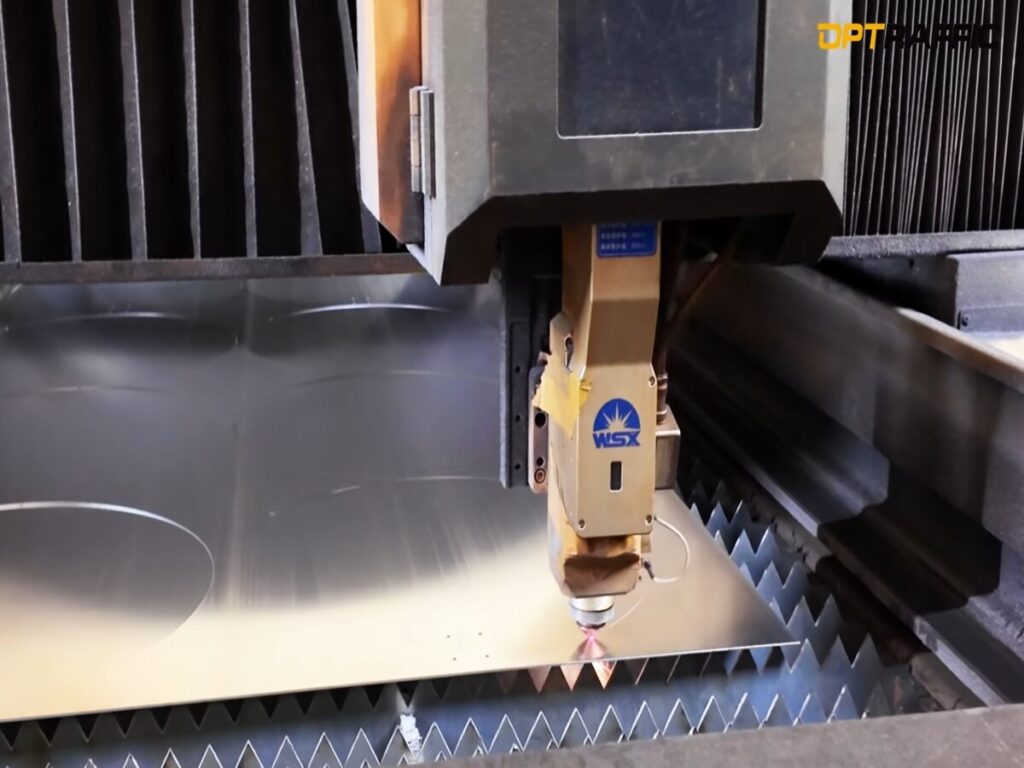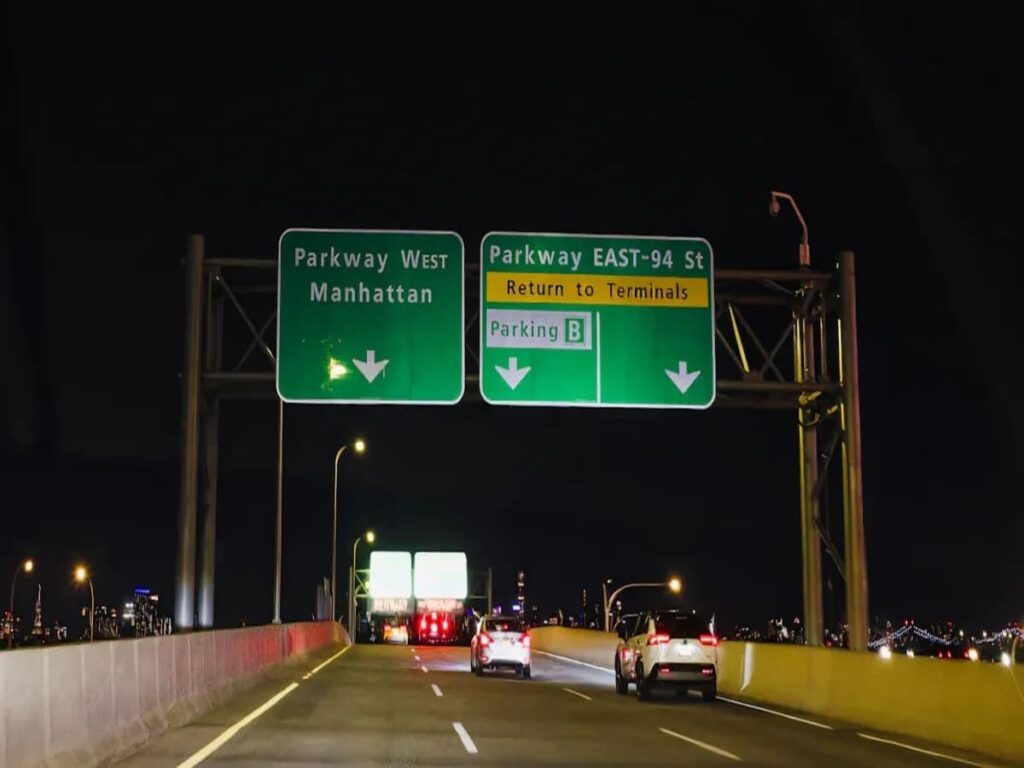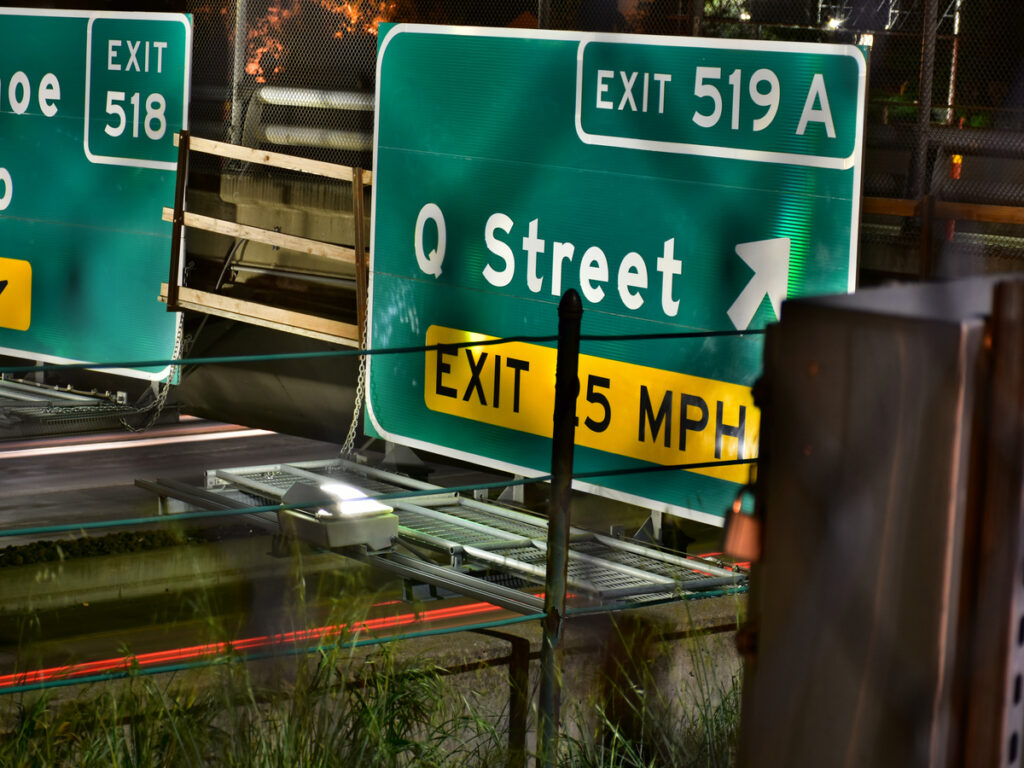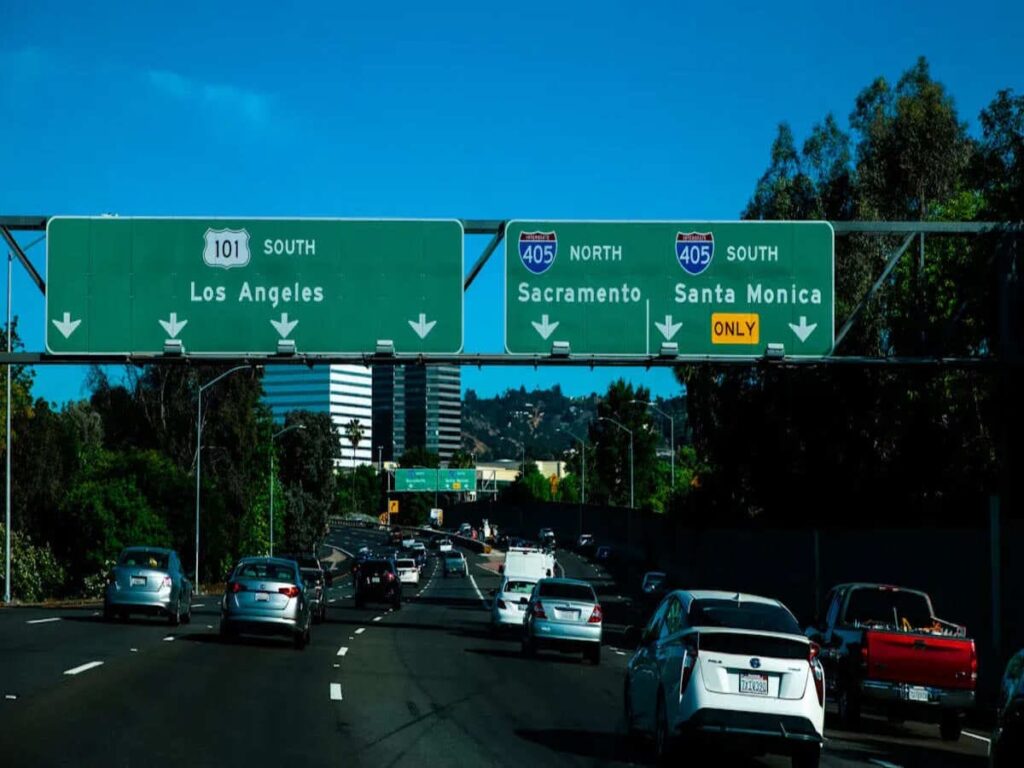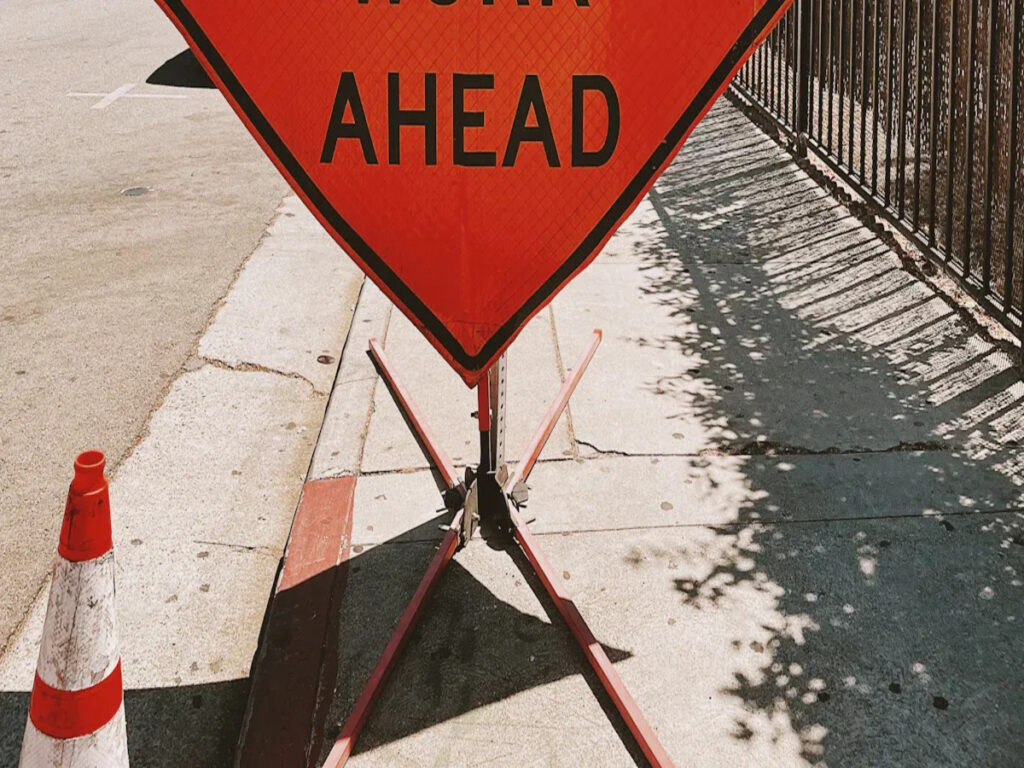
لا تزال العلامات الإلزامية مهمة جدًا في كل مشروع طريق طويل المدى, حتى في حالة وجود شاشات VMS متقدمة. يجب على شركات البناء اتباع قواعد صارمة لإشارات المرور الخاصة ببناء الطرق. تساعد العلامات الواضحة وسهلة الرؤية في الحفاظ على سلامة العمال والسائقين. تستخدم هذه العلامات الإلزامية مواد عاكسة وألوان زاهية. إنهم يقدمون إرشادات ثابتة ويجعلون القواعد واضحة. يوفر VMS تحديثات في الوقت الفعلي, لكن العلامات الإلزامية فقط هي التي تحافظ دائمًا على سلامة الأشخاص واتباع القواعد. تساعد العلامات الجيدة في إدارة حركة المرور وإبقاء الجميع على اطلاع أثناء المشروع, حتى عندما تتغير الأمور.
تقدم OPTRAFFIC مجموعة كاملة من علامات إلزامية و مقطورات VMS, موثوق به من قبل المقاولين في جميع أنحاء أستراليا. سواء كنت تدير منطقة عمل, التفاف, أو مشروع بنية تحتية رئيسية, توفر OPTRAFFIC حلول اللافتات التي تحافظ على مشروعك آمنًا وفي الموعد المحدد.
الوجبات الرئيسية
- يجب استخدام علامات الطريق الإلزامية بموجب القانون. أنها تعطي قواعد واضحة وثابتة. تساعد هذه القواعد في الحفاظ على سلامة السائقين والعاملين أثناء المشاريع طويلة الأجل.
- علامات الرسائل المتغيرة (VMs) تقديم تحديثات حية مفيدة. لكنها لا تستطيع أن تحل محل العلامات الإلزامية الثابتة. قد يتوقف نظام VMS عن العمل أو يؤدي إلى إرباك السائقين.
- إن استخدام المعايير الأسترالية والدولية يضمن إمكانية رؤية العلامات. كما أنه يتأكد من أن العلامات تعمل بشكل جيد وتتبع القانون أثناء المشروع.
- يساعد استخدام كل من العلامات الثابتة ونظام VMS في الأماكن الذكية السائقين على الفهم بشكل أفضل. وهذا يساعد أيضًا في التحكم في حركة المرور بطريقة آمنة وجيدة.
- غالبًا ما يؤدي فحص جميع العلامات وإصلاحها إلى إيقاف وقوع الحوادث. كما أنه يساعد على تجنب الغرامات ويحافظ على مشاريع الطرق آمنة وتعمل بشكل جيد.
العلامات الإلزامية والامتثال القانوني
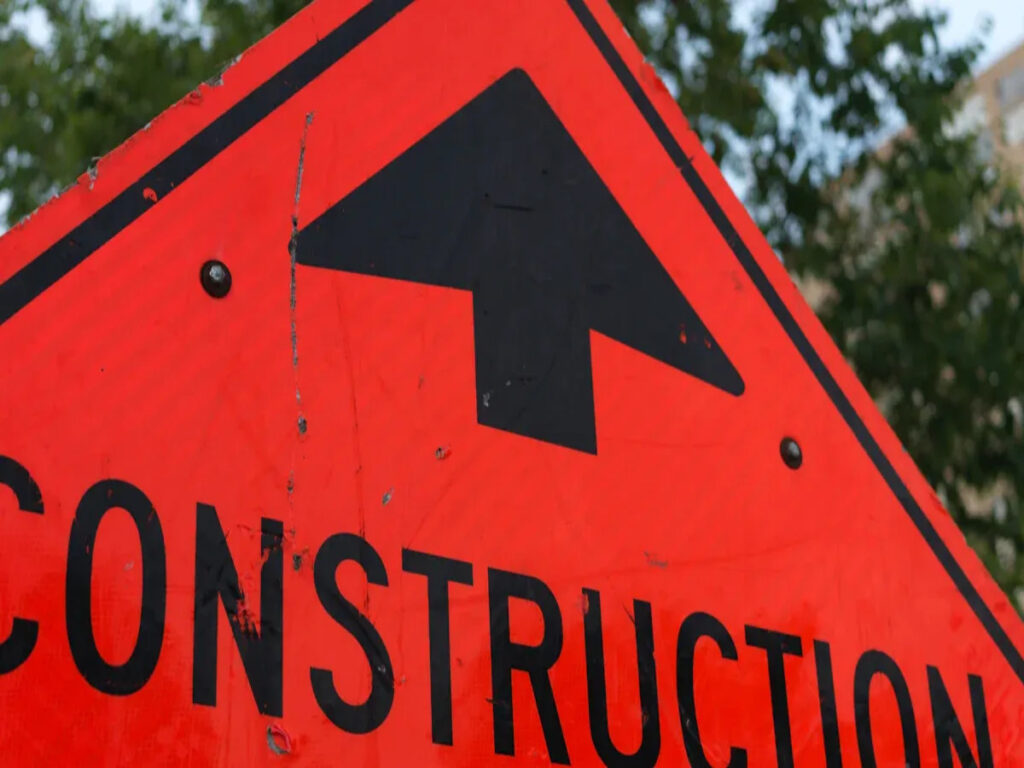
معايير إشارات المرور الخاصة ببناء الطرق
تعتبر إشارات المرور الخاصة ببناء الطرق مهمة جدًا للمشاريع طويلة المدى. المعايير الأسترالية مثل 1742 و 1743 وضع قواعد صارمة لهذه العلامات. تضمن هذه القواعد بقاء العلامات واضحة وسهلة الرؤية خلال المشروع بأكمله. يجب أن تتبع جميع العلامات الإلزامية هذه المعايير حتى تكون قانونية وآمنة.
- يجب أن تتبع العلامات التنظيمية AS 1742 و 1743 أن تكون قانونية.
- العلامات لها رموز الحجم, السلسلة أ إلى د, لتناسب سرعة الطريق والمنطقة.
- تستخدم اللافتات الدائمة مواد قوية مثل الألومنيوم أو الفولاذ المجلفن.
- وضع جيد, الحجم الصحيح, والفحوصات تبقي العلامات تعمل بشكل جيد.
- العلامات الإلزامية الشائعة هي توقف, افسح الطريق, الحد الأقصى للسرعة, ممنوع الدخول, وتقييد وقوف السيارات. ولكل منها شكلها وحجمها الخاص.
- تحتاج أعمال الطرق طويلة المدى إلى علامات ثابتة, مثل الأعمدة المجلفنة ذات القواعد الانفصالية, من أجل السلامة.
تنص المعايير الأسترالية أيضًا على استخدام أجهزة خاصة للتحكم في حركة المرور لتحذير الأشخاص وتوجيههم خلال مواقع العمل. يجب أن تتبع العلامات قواعد التنسيق, مقاس, والمواد العاكسة لتبقى مرئية طوال الوقت. إن وضع اللافتات في المكان المناسب يساعد في الحفاظ على سلامة الأشخاص واتباع القواعد. إن فحص العلامات وإصلاحها يجعلها تعمل ويسهل رؤيتها أثناء المشروع. تضمن هذه القواعد أن جميع العلامات قانونية وآمنة, حتى يتمكن الناس من الوثوق بهم.
لدى ولايات مثل نيو ساوث ويلز وفيكتوريا قواعد إضافية لإشارات المرور الخاصة ببناء الطرق. يوضح الجدول أدناه بعض الاختلافات الرئيسية في قواعدهم:
| الجانب التنظيمي | نيو ساوث ويلز (نيو ساوث ويلز) | فيكتوريا (فيك) |
|---|---|---|
| التنسيب والتخليص | يحافظ على مناطق واضحة ويتجنب عرقلة حركة المرور أو الأشخاص. | يحدد الحد الأدنى للارتفاعات والمسافات من التقاطعات. |
| التصريح والموافقة | يحتاج إلى تصاريح من المجالس المحلية وRMS. | يحتاج إلى تصاريح من VicRoads والمجالس المحلية. |
| المعايير الفنية | يركز على الاستقرار وإمدادات الطاقة. | يركز على التحكم في السطوع والتثبيت القوي. |
| التنسيق مع السلطات | يعمل مع المجالس المحلية و RMS. | يعمل مع VicRoads والمجالس المحلية. |
المعايير الدولية مثل اتفاقية فيينا و ISO 7010 قل أيضًا أن العلامات يجب أن تكون واضحة وأن تبدو متماثلة في كل مكان. تتطابق المعايير الأسترالية مع القواعد العالمية ولكنها تتغير قليلاً بالنسبة للطقس المحلي والحيوانات. تحتاج القواعد العالمية والأسترالية إلى علامات إلزامية مثل حدود السرعة وإشارات التوقف للحفاظ على سلامة الطرق. VMS يعطي تحديثات حية, لكن العلامات الثابتة فقط هي التي تلبي القواعد القانونية للمشاريع طويلة الأجل.
التنفيذ والعقوبات
العلامات الإلزامية هي الأساس القانوني للقواعد في كل مشروع لبناء الطرق. علامات ثابتة, طرحها من قبل القواعد, دع السلطات تعطي غرامات لعدم اتباعها. يمكن لـ VMS تقديم معلومات إضافية, لكن العلامات الثابتة فقط لها قوة قانونية.
- عدم اتباع علامات البناء الإلزامية يمكن أن يعني غرامات كبيرة.
- تضع مجموعات مثل OSHA وANSI قواعد صارمة لعلامات البناء.
- تساعد هذه الغرامات في التأكد من اتباع الأشخاص لقواعد السلامة في المشاريع طويلة الأجل.
- السبب الرئيسي لهذه القواعد هو الحفاظ على سلامة العمال وتقليل مخاطر الحوادث, ليس فقط لتجنب الغرامات.
التحكم المؤقت في حركة المرور يحتاج إلى وضوح, علامات قانونية لتوجيه السائقين بأمان. إذا كان المشروع لا يحتوي على العلامات الصحيحة, يمكن أن تفشل الشيكات, يتأخر, أو الحصول على تقارير لعدم اتباع القواعد. قد تطلب سلطات الولاية إجراء إصلاحات أو فرض عقوبات إذا كانت العلامات مفقودة أو خاطئة. توضح هذه المشكلات سبب أهمية اتباع جميع القواعد لكل مشروع طريق.
إن اتباع قواعد إشارات المرور الخاصة ببناء الطرق يضمن أن كل مشروع قانوني وآمن. يجب على شركات البناء طرح, يفحص, وإصلاح العلامات لتجنب الغرامات والحفاظ على سلامة الجميع على الطريق.
قيود نظام إدارة السفن (VMS) في مناطق أعمال الطرق الأمامية
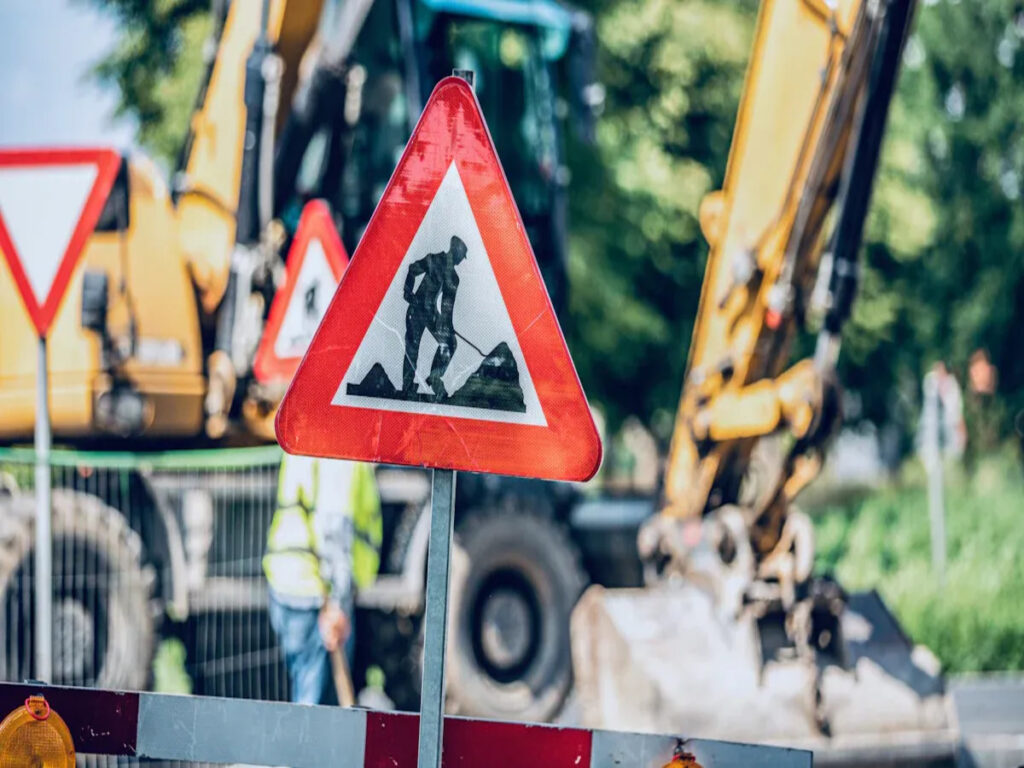
قضايا الموثوقية
يمكن أن تكون مناطق العمل على الطرق أمامك خطرة على السائقين والعمال. يجب أن تعطي اللافتات دائمًا تحذيرات واضحة وأن تكون سهلة الرؤية. VMs, أو علامات الرسالة المتغيرة, المساعدة من خلال تقديم المشورة في هذه المجالات. لكنها لا تستطيع أن تحل محل العلامات الإلزامية. وهذا صحيح جدًا عندما تكون هناك حاجة إلى تحذيرات بشأن العمل على الطريق من أجل السلامة واتباع القواعد.
تواجه VMS العديد من المشاكل في مناطق أعمال الطرق المقبلة:
- يمكن أن يشعر السائقون بالارتباك إذا كان هناك عدد كبير جدًا من الرسائل.
- الكثير من المعلومات أو الكثير من التغييرات تجعل من الصعب قراءة العلامات.
- الأوقات القصيرة للرسائل والتغييرات السريعة تجعل من الصعب فهمها.
- سوء الأحوال الجوية مثل المطر أو الضباب يجعل رؤية VMS أكثر صعوبة.
- تؤثر الطريقة التي يتم بها تصنيع مصابيح LED والصور على مدى رؤية السائقين لها.
- قد يشعر السائقون بالارتباك إذا كانت التحذيرات صعبة للغاية أو غير واضحة.
ملحوظة: تقول الدراسات أن الرسائل يجب أن تكون قصيرة, مع جزأين فقط, وتظهر لمدة خمس ثوان لإبقاء اللافتات سهلة الرؤية وآمنة.
الرؤية والاستمرارية
تعد القدرة على رؤية اللافتات أمرًا مهمًا جدًا في مناطق أعمال الطرق المقبلة. العلامات الثابتة تعطي دائمًا تحذيرات وقواعد, حتى لو توقف نظام VMS عن العمل أو انقطعت طاقته. تستخدم هذه اللافتات مواد لامعة حتى يتمكن الناس من رؤيتها ليلاً أو في الأحوال الجوية السيئة. بنيتها القوية ونقاطها الثابتة تعني أن السائقين يرون دائمًا علامات التحذير ورسائل إغلاق الممرات.
يمكن للإشارات الثابتة التعامل مع ظروف الطريق الصعبة والتحذير دائمًا من المخاطر, الممرات المغلقة, وأعمال الطريق المقبلة. إذا توقف VMS عن العمل أو كان بحاجة إلى الإصلاح, لا تزال العلامات الثابتة تعطي رسائل أمان مهمة. وهذا يساعد السائقين على البقاء آمنين وعدم الخلط, خاصة في المشاريع الطويلة حيث يجب أن تكون التحذيرات واضحة دائمًا.
يؤدي استخدام كلا النوعين من الإشارات إلى التأكد من سهولة رؤية التحذيرات ورسائل الممرات المغلقة دائمًا. السلامة على الطرق تحتاج إلى علامات واضحة لا تزول, خاصة عندما تحدث المخاطر وتغييرات الطريق في كثير من الأحيان.
سلوك السائق والتعرف على اللافتات
الإلمام بالعلامات الإلزامية
يرى السائقون إشارات المرور الخاصة ببناء الطرق كل يوم. هذه العلامات لها نفس الأشكال والألوان. هذا يجعلها سهلة على اكتشافها. عندما يقترب السائقون من منطقة عمل الطريق أمامهم, يبحثون عن هذه العلامات. إن رؤية العلامات المألوفة تساعد السائقين على التصرف بسرعة واتباع القواعد. علامات ثابتة, مثل حدود السرعة أو أسهم الالتفاف, البقاء في مكان واحد. من السهل دائمًا رؤيتهم. يثق السائقون بهذه العلامات لأن القواعد لا تتغير بسرعة.
بحثت دراسة جديدة في مدى جودة اتباع السائقين للإشارات الثابتة والديناميكية في مناطق إنشاء الطرق. وأظهرت النتائج أن كلا النوعين لهما معدلات امتثال مماثلة في الحياة الواقعية. في جهاز محاكاة, اتبع المزيد من السائقين القواعد, لكن نوع الإشارة لم يكن مهمًا كثيرًا.
| نوع الدراسة | نوع علامة | معدل الامتثال | ملحوظات |
|---|---|---|---|
| دراسة ميدانية | علامة ثابتة | 12.5% | لا يوجد فرق كبير في الامتثال مقارنة بالإشارات الديناميكية |
| دراسة ميدانية | علامة ديناميكية (نظام إدارة الوجهات السياحية/نظام إدارة السفن) | 12.9% | معدل الامتثال تقريبا نفس العلامات الثابتة |
| محاكي القيادة | كلا النوعين من الإشارات | 70% | اتبع المزيد من السائقين القواعد; نوع الإشارة أو موضعها لم يغير هذا |
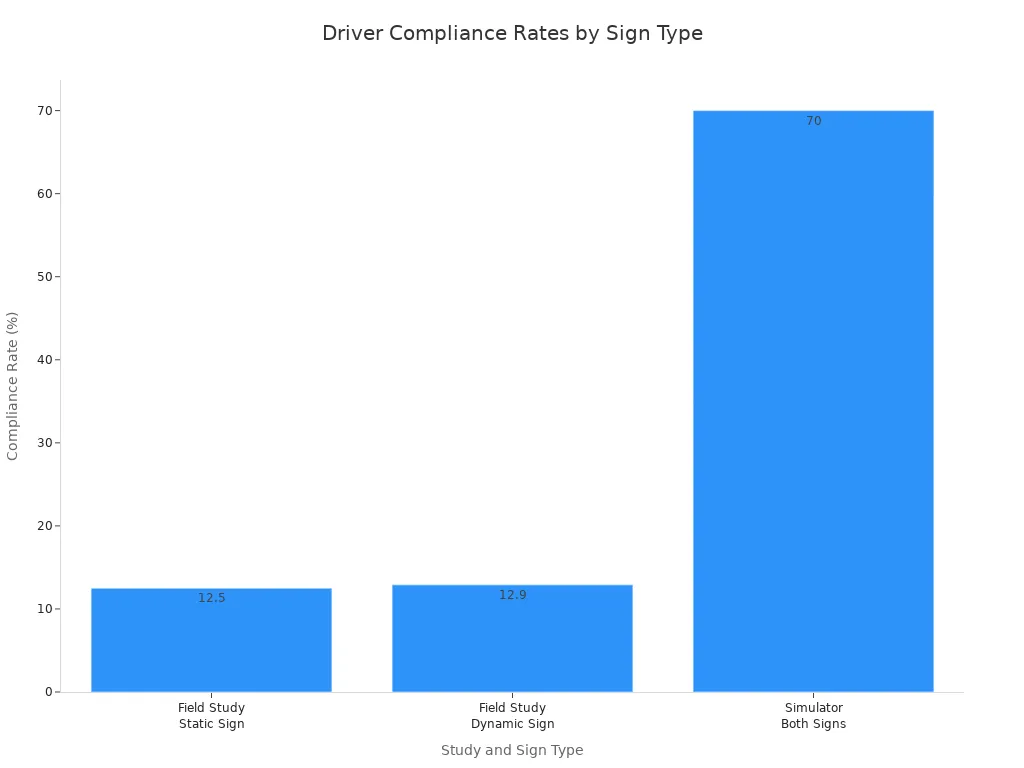
تقليل الارتباك
علامات تساعد على وقف الارتباك لجميع السائقين, خاصة الأكبر سنا. تساعد إشارات المرور الخاصة بإنشاء الطرق، والتي تحتوي على كلمات واضحة ورؤية جيدة، السائقين على اتخاذ خيارات آمنة. غالبًا ما يحتاج السائقون الأكبر سنًا إلى مزيد من الوقت لفهم الإشارات. تمنحهم العلامات الثابتة ذات الأضواء الساطعة وقتًا إضافيًا للرؤية والفهم. وهذا يساعدهم على الاستعداد لتغيير المسار أو التحويلات.
- يعمل السائقون الأكبر سنًا بشكل أفضل من خلال وضع علامات إلزامية متباعدة واستخدامها في مجموعات ذات أضواء وامضة, لأن هذه تعطي مزيدًا من الوقت للرؤية والاستعداد.
- إن رؤية العلامات الإلزامية لفترة أطول تساعد السائقين الأكبر سناً على الاستجابة بشكل أسرع وبقدر أقل من الشك.
- تعمل مجموعات من العلامات الثابتة ذات الأضواء الساطعة على إبطاء حركة السيارات بالقرب من إغلاق المسار.
- يفضل السائقون الأكبر سنًا في مجموعات التركيز وجود المزيد من العلامات التحذيرية ومناطق الدمج الأطول من أجل تحركات أكثر أمانًا.
- تحتاج شاشات VMS إلى أحرف كبيرة وكلمات واضحة حتى يمكن رؤيتها جيدًا, لكن العلامات الثابتة تعطي مساعدة ثابتة.
يجب أن تكون إشارات المرور الخاصة بإنشاء الطرق سهلة الرؤية في جميع الأحوال الجوية. تضمن العلامات الجيدة ملاحظة السائقين للتحذيرات بشأن أعمال الطريق المقبلة, المخاطر, والالتفاف. هذا يبقي الجميع أكثر أمانًا على الطريق.
دمج اللافتات للسلامة على الطرق
وضع أفضل الممارسات
إن وضع العلامات المرورية الخاصة بإنشاء الطرق في الأماكن الصحيحة يحافظ على سلامة مناطق العمل. تقوم الفرق بوضع علامات ثابتة في أماكن منتظمة قبل وداخل منطقة المشروع. تعطي هذه العلامات تحذيرات واضحة بشأن السرعة, الالتفاف, والمخاطر. شاشات VMS محمولة وتوفر تحديثات مباشرة أو تنبيهات في حالات الطوارئ. تضع الفرق نظام VMS حيث يجب على السائقين اتخاذ الاختيارات, كما هو الحال قبل إغلاق الممرات أو تحويلات المشاة, حتى يتمكن السائقون من رؤيتها بسهولة.
نصيحة: تأكد دائمًا من عدم وجود أي شيء يعيق أي علامات مرورية خاصة بإنشاء الطرق أو شاشات VMS.
يوضح الجدول أدناه أفضل الطرق لاستخدام كل من إشارات المرور الثابتة وإشارات إنشاء الطرق VMS:
| وجه | المبدأ التوجيهي / توصية |
|---|---|
| علامات ثابتة | استخدم للقواعد وعلامات الالتفاف. ضعهم في المكان المناسب واحتفظ بهم في حالة جيدة. |
| VMs | استخدم للتحذيرات الحية, أخبار الطوارئ, وتغير ظروف الطريق. |
| مزيج | ضع نظام VMS بالقرب من الإشارات الثابتة لمساعدة السائقين على الفهم وعدم الخلط. |
| الرؤية | تأكد من إمكانية رؤية كلا النوعين من العلامات في جميع الأحوال الجوية والضوء. |
| أمان | استخدم VMS لرسائل الطوارئ ودعم التحذيرات الثابتة. |
| صيانة | تحقق من جميع العلامات بشكل متكرر لإبقائها تعمل بشكل جيد واتباع القواعد. |
يساعد وضع إشارات المرور الثابتة وإشارات إنشاء الطرق VMS في أماكن ذكية على التحكم في حركة المرور ويمنع الأشخاص من تفويت التحذيرات. يساعد الوضع الجيد أيضًا على اتباع قواعد علامات السلامة على الطرق.
الأدوار التكميلية
تقوم كل من علامات المرور الخاصة بإنشاء الطرق وشاشات VMS بوظائف مختلفة للتحكم في حركة المرور. تُظهر العلامات الثابتة دائمًا نفس الرسائل المتعلقة بالسرعة, الالتفاف, وتغييرات المسار. يمكن أن تتغير شاشات VMS بسرعة في حالة وجود خطر أو تغيير خطة المشروع. باستخدام كلتا الوسيلة، يحصل السائقون والمشاة على المعلومات الصحيحة في الوقت المناسب.
- تساعد العلامات الواضحة السائقين على معرفة الطرق الالتفافية, يتغير حارة, وسرعات أبطأ.
- إن فحص جميع إشارات المرور الخاصة بإنشاء الطرق وشاشات VMS غالبًا ما يحافظ على الأمور آمنة وقانونية.
- يساعد الاستماع إلى السائقين والعاملين الفرق على تحريك اللافتات أو تغيير الرسائل بسرعة.
- علامات خاصة لإدارة المرور, مثل VMS الآلي, المساعدة في حالات الطوارئ.
يجب ألا تستخدم الفرق عددًا كبيرًا جدًا من إشارات المرور أو الرسائل الصعبة الخاصة بإنشاء الطرق. قصير, تساعد التحذيرات البسيطة وإشارات الانعطاف السائقين على الانتباه وعدم الخلط. استخدام جميع أنواع الإشارات الإنشائية بالطريقة الصحيحة, بما في ذلك المشاة وحالات الطوارئ, يحافظ على مناطق العمل آمنة خلال المشروع بأكمله.
هناك حاجة إلى علامات إلزامية بموجب القانون في كل مشروع طريق. فهي موثوقة للغاية للسائقين والعمال. إن استخدام نظام VMS مع اللافتات الثابتة يجعل الطرق أكثر أمانًا. كما أنه يساعد الجميع على اتباع القواعد. يحصل السائقون دائمًا على تعليمات واضحة بهذه الطريقة. إن الفحوصات المنتظمة واتباع القواعد تحافظ على سلامة الطرق. يوضح الجدول أدناه لماذا تساعد الفحوصات المنتظمة في مشاريع الطرق:
| فائدة | توضيح |
|---|---|
| زيادة الكفاءة | الشيكات تبقي العلامات جيدة وتوقف الإصلاحات المكلفة. وهذا يحافظ على الطرق آمنة لجميع السائقين. |
| وفورات التكلفة | التحقق من العلامات مبكرًا يوقف المشاكل الكبيرة ويوفر المال. كما أنها تحافظ على العلامات القانونية. |
| إدارة أفضل للمشروع | تساعد الشيكات المديرين على تخطيط المشاريع والحفاظ عليها في الوقت المحدد. |
| تعزيز السلامة | التحقق من تقليل المخاطر للسائقين والعمال أثناء المشروع. |
| تحسين الإنتاجية | إن اكتشاف المشكلات مبكرًا يبقي المشاريع قيد التنفيذ لجميع مستخدمي الطريق. |
من الأفضل التحقق من إشارات الطريق كثيرًا لاتباع القواعد:
- يجب على الوكالات التحقق من علامات الحد الأقصى للسرعة في كثير من الأحيان.
- تتأكد عمليات الفحص المنتظمة من أن اللافتات تتوافق مع أحدث القواعد.
- تحتاج الطرق المزدحمة إلى مزيد من الفحوصات على المعدات.
- مرة واحدة في السنة, تحقق من جميع العلامات لإبقائها تعمل.
- قم بتغيير العلامات عندما تتقدم في السن أو تتهالك.
- احتفظ بسجلات لتعرف متى تحتاج العلامات إلى الإصلاح.
يجب على مديري الطرق دائمًا استخدام اللافتات الثابتة وإشارات VMS. وهذا يحافظ على سلامة جميع السائقين واتباع القواعد.
التعليمات
ما هو الفرق الرئيسي بين العلامات الإلزامية وشاشات VMS؟?
تظهر العلامات الإلزامية دائمًا نفس القواعد, مثل حدود السرعة أو التوقف. يمكن لشاشات VMS تغيير رسائلها لإعطاء تحديثات أو تحذيرات جديدة. كلا النوعين يساعدان السائقين على فهم ما يجب عليهم فعله. لكن العلامات الإلزامية فقط مطلوبة بموجب القانون للمشاريع طويلة الأجل.
لماذا لا تزال المشاريع طويلة الأجل بحاجة إلى إشارات ثابتة في حالة وجود نظام VMS؟?
يمكن دائمًا رؤية العلامات الثابتة, حتى لو انقطعت الكهرباء. لا يحتاجون إلى أي تكنولوجيا للعمل. تستخدم السلطات هذه العلامات للتأكد من أن الناس يتبعون القواعد. يساعد VMS من خلال تقديم معلومات إضافية, لكنها لا يمكن أن تحل محل العلامات الثابتة في مناطق العمل طويلة المدى.
من يتحقق مما إذا كانت مشاريع الطرق تستخدم معدات التحكم في حركة المرور الصحيحة?
سلطات الدولة والمجالس المحلية تتفقد مشاريع الطرق. إنهم يتطلعون لمعرفة ما إذا كان يتم استخدام معدات التحكم في حركة المرور الصحيحة. يتضمن ذلك كلا من العلامات الثابتة وVMS. يجب أن تتبع المشاريع المعايير الأسترالية لاجتياز هذه الاختبارات.
هل يمكن لشاشات VMS أن تحل محل جميع العلامات الثابتة في مناطق العمل على الطرق?
لا يمكن لشاشات VMS أن تحل محل جميع العلامات الثابتة. تعطي العلامات الثابتة تعليمات واضحة ودائمة. تقدم VMS تفاصيل إضافية ولكنها لا تتمتع بنفس القوة القانونية التي تتمتع بها الإشارات الإلزامية.


